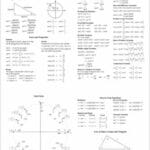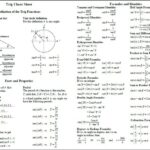Unlock the secrets of sine, cosine, and tangent with this comprehensive trigonometric identities cheat sheet. This guide is designed to be your roadmap—your key to understanding and applying trigonometric identities, from basic to advanced.
Decoding the Trig Identity Sheet
A trig identity sheet is more than just a list of formulas; it’s a dynamic toolkit for navigating the world of trigonometry. Imagine trying to build a house without knowing which tool to use—a hammer, a saw, or a screwdriver. Similarily, tackling trigonometry requires understanding which identities are essential for each task, whether it’s simplifying an expression or solving a complex equation.
Organizing the Identities: Categories are Key
A well-organized identity sheet groups formulas into logical categories, much like a toolbox keeps similar tools together. This organization is essential for finding the right “tool” quickly and efficiently. Common categories include:
- Pythagorean Identities: These fundamental identities connect sine, cosine, and tangent. They’re likely the most recognized and frequently used.
- Reciprocal Identities: These define the relationships between pairs of functions, such as sine and cosecant. They’re essential for simplifying expressions involving fractions and reciprocals.
- Quotient Identities: These identities express tangent and cotangent in terms of sine and cosine, offering an alternative representation for these functions.
- Co-function Identities: These identities link functions of complementary angles. They can be highly effective when dealing with angles that sum to 90 degrees.
- Sum and Difference Identities: These formulas allow you to work with the trigonometric functions of the sum or difference of two angles. They can be a bit involved but are indispensable for expanding or condensing expressions.
- Double-Angle Identities: These formulas provide shortcuts for working with double angles, allowing you to rewrite expressions in terms of single angles.
- Half-Angle Identities: These can be somewhat complex, often involving square roots. They provide a way to express trigonometric functions of half an angle in terms of the full angle.
- Sum-to-Product and Product-to-Sum Identities: These specialized formulas allow converting between sums and products of trigonometric functions, which can be very useful in certain advanced applications.
Why They Work: Derivations and the Big Picture
Memorizing formulas without understanding their origins is like learning vocabulary without grammar—you might get by, but you won’t truly grasp the language. Seeing how one identity flows from another illuminates the interconnectedness of trigonometry, enhancing understanding and retention. Some research suggests that focusing on derivations significantly improves long-term retention and application of these mathematical tools.
Putting Identities to Work: Practical Applications
Trig identities are your problem-solving arsenal. They are indispensable for:
- Simplifying Expressions: Reduce complex trigonometric expressions to more manageable forms.
- Solving Equations: Manipulate equations involving trigonometric functions to find solutions. This is where understanding the categories and applying the correct identity becomes so important.
- Verifying Identities: Prove that one side of a trigonometric equation equals the other by strategically manipulating one or both sides. The choice of which identity or combination of identities to apply is where practice really makes a difference.
Memorization Techniques: Making It Stick
Memorizing numerous formulas can be challenging, but effective strategies exist. Mnemonics, visual aids, flashcards, and spaced repetition can be immensely helpful. Also, consider exploring online interactive quizzes or engaging with video tutorials on platforms like Khan Academy or YouTube channels like Professor Leonard’s or The Organic Chemistry Tutor for alternative learning and memorization techniques.
Why Are Trig Identities Important?
Trig identities are the bedrock of trigonometry, enabling us to manipulate and simplify complex expressions, solve equations, and explore the very fabric of wave phenomena. Their importance extends far beyond the classroom, underpinning fields like physics, engineering, computer graphics, and even music theory.
Beyond Memorization: A Deeper Understanding
Don’t just memorize formulas; strive to understand the principles behind them. A trig identity sheet is like a map—knowing the landmarks (identities) is important, but understanding the terrain (the relationships between them) makes you a true navigator.
Trig Identities in Action: Real-World Applications
Consider how waves, whether sound waves or electromagnetic waves, permeate our world. Trig identities are essential for describing their behavior and properties. In engineering, they’re crucial for design and analysis, from designing bridges to optimizing signal transmission. Even in creating realistic computer graphics, understanding trigonometric identities helps render curves, surfaces, and lighting effects accurately.
A Dynamic Field: Ongoing Research and Exploration
Trigonometry, like any branch of mathematics, is a subject of ongoing research. While current knowledge provides a comprehensive foundation, further studies may refine our understanding or lead to the discovery of new related identities and applications, especially with the increasing use of computational methods in mathematical research.
Key Trig Identities Explained
This section provides a concise explanation of the reciprocal, quotient, and Pythagorean identities, highlighting their roles as the foundational “building blocks” of trigonometry.
Reciprocal Identities
These identities define the reciprocal relationships between the six trigonometric functions. In essence, they state that each trigonometric function can be defined as the inverse of another:
sin(θ) = 1/csc(θ)cos(θ) = 1/sec(θ)tan(θ) = 1/cot(θ)csc(θ) = 1/sin(θ)sec(θ) = 1/cos(θ)cot(θ) = 1/tan(θ)
Quotient Identities
Quotient identities express tangent and cotangent in terms of sine and cosine:
tan(θ) = sin(θ)/cos(θ)cot(θ) = cos(θ)/sin(θ)
These relationships are derived directly from the definitions of the trigonometric functions within a right triangle, connecting the ratios of different sides.
Pythagorean Identities
Derived from the Pythagorean theorem, these crucial identities link sine and cosine, tangent and secant, and cotangent and cosecant:
sin²(θ) + cos²(θ) = 11 + tan²(θ) = sec²(θ)1 + cot²(θ) = csc²(θ)
These identities are invaluable for simplifying expressions and are often the starting point for proving more complex trigonometric relationships.
| Identity Category | Example Identity | Description |
|---|---|---|
| Pythagorean Identities | sin²θ + cos²θ = 1 | Relates the squares of sine and cosine. |
| Reciprocal Identities | cscθ = 1/sinθ | Defines cosecant as the reciprocal of sine. |
| Quotient Identities | tanθ = sinθ/cosθ | Defines tangent as the ratio of sine to cosine. |
| Double-Angle Identities | sin(2θ) = 2sinθcosθ | Expresses the sine of twice an angle in terms of sine and cosine of the single angle. |
| Half-Angle Identities | sin(θ/2) = ±√[(1-cosθ)/2] | Expresses the sine of half an angle in terms of the cosine of the single angle. The ± sign indicates that the correct sign depends on the quadrant in which θ/2 lies. |
| Sum-to-Product Identities | sinα + sinβ = 2sin[(α+β)/2]cos[(α-β)/2] | Converts a sum of sines into a product of sine and cosine. |
| Sum and Difference Identities | sin(α ± β) = sinαcosβ ± cosαsinβ | Expresses the sine of the sum or difference of two angles. |
| Co-function Identities | sin(θ) = cos(90° – θ) | Relates trigonometric functions of complementary angles. |
By mastering these core identities, you’ll be well-equipped to tackle more advanced trigonometric concepts and applications.
Recommended Titles (Submit Competitor Titles for Analysis)
Please provide competitor article titles so I can create three highly optimized alternatives.
- Unlock Elemental 2 Secrets: Actionable Insights Now - April 2, 2025
- Lot’s Wife’s Name: Unveiling the Mystery of Sodom’s Fall - April 2, 2025
- Photocell Sensors: A Complete Guide for Selection and Implementation - April 2, 2025
















